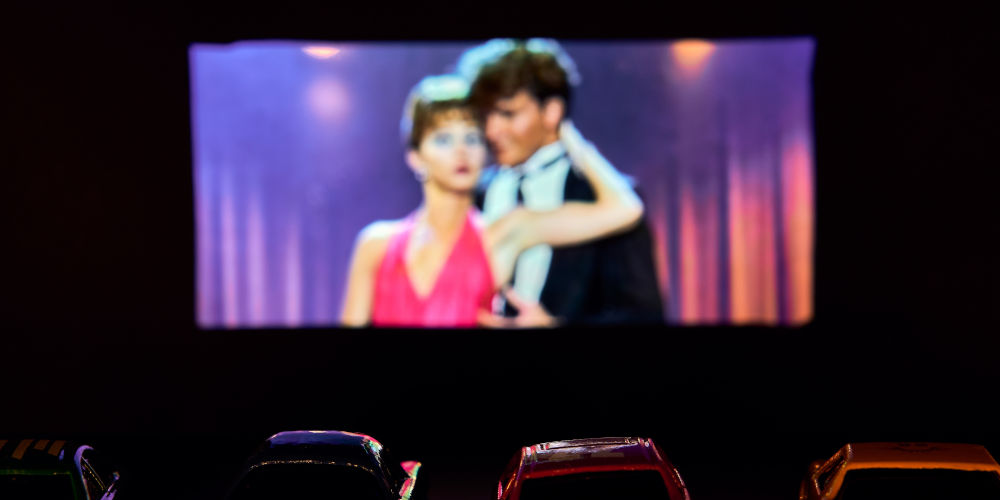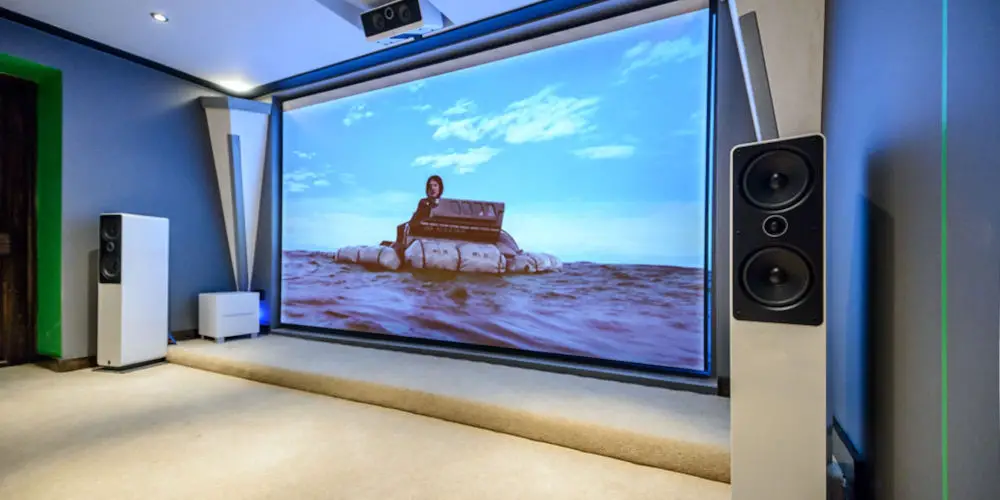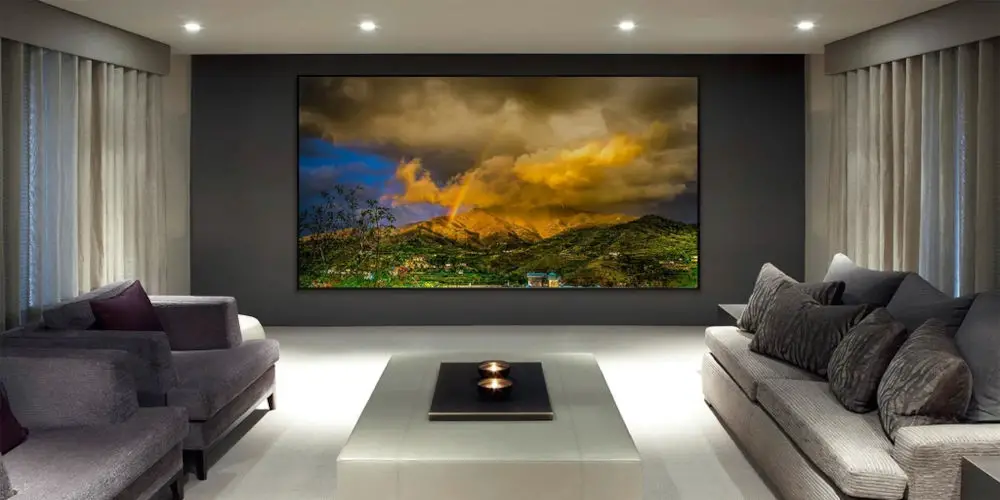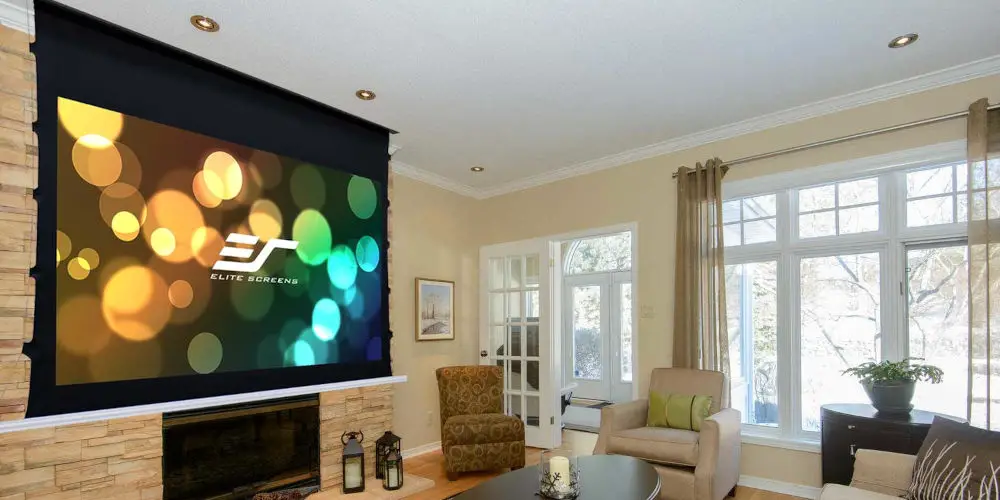Projector screen buying guide: What is your ideal option?

Without the right screen, even the most expensive, top-of-the-range projector won’t provide the best viewing experience possible. In this projector screen buying guide, you’ll learn how to find the right option for your projector, room and requirements.
If you’re just starting your home cinema journey, you might want to look at our projector buying guide. It has plenty of advice, whether you’re buying your first projector or upgrading.
In this projector screen buying guide, we’ll cover the basic terminology, what options are available and how to ensure you get the best possible picture. So grab some popcorn!
Why use a screen?
You might question the need for a projector screen, especially when you can paint an existing wall white (with specialist projector paint) and be done with it! However, even the flattest of walls will still have minor imperfections which will impact the projected image.
Using a screen removes all lumps and bumps that might affect the picture quality. Most screens have a black border around them, which helps frame your movies and TV shows.
A screen also gives you a bit more control over how much light gets reflected: a screen with a matte coating will have a much easier time of keeping ambient light from ruining your image.
Finally, it’s far easier to move a screen than having to repaint!
What your ideal screen size?
The motto when buying a TV is big is best! In most living rooms, a 50-inch TV will fit well and provide a fantastic viewing experience from multiple angles. That said, when choosing a projector screen, you’ll be limited by your space.
Comfortable viewing angle
As the goal is to create a comfortable viewing angle from multiple positions, you should mount the screen at least 30 cm (a foot) from your ceiling. Doing this prevents you (or people in the back row!) from having to crane your neck to see properly.
Ideally, your screen should be mounted at least 60 cm from the floor as this will elevate it above furniture and speakers, allowing for a comfortable viewing angle.
In practice, you could easily use a 98-inch screen in a room with a 2.5 metre (8 foot) ceiling as this would leave around a metre margin at the bottom with a 30 cm margin at the top.
Projector brightness
Another element to consider when deciding on screen size is projector brightness. As you want to maximise brightness, you need to balance screen size and distance from the projector and screen.
For example, trying to fill a massive screen, will mean the projector needs to be far away from it. You’ll likely notice a drop in brightness and increased pixelation of the picture. Even moving the projector a metre closer to the screen will provide a brighter picture, albeit slightly smaller.
You should, therefore, ensure the size of your intended screen falls safely within the range listed in your projector’s specs.
Seating distance
Screen size also impacts where you can sit and while the ideal viewing distance is very subjective, it’s an important factor to consider. Again you want to optimise so that all seats in your home cinema can easily and comfortably view the screen.
It also depends on your set-up. For example, for the best 4K picture, you will want to sit closer to the screen to better experience the exceptional picture detail and depth.
For a 1080p HD projector, a good rule of thumb for viewing distance is 1 and 1/2 times the screen diagonal. So if your screen’s diagonal measurement is 96-inch (2.5 metres), you should sit roughly 4 metres (3.66 m to be exact) from the screen.

photo by PSM Screens
Typical projector screen materials
The majority of projector screens are made from vinyl material, which ensures a smooth-looking picture. Special coatings on the vinyl material change the way the projector’s light is reflected back at viewers.
These coatings affect picture qualities like brightness, contrast, and viewing angle. Understanding a little about them can help you better match a screen to your projector and room.
Projector screens come in sizes that dwarf even large TVs. You can buy screens up to 180-inch in size! That said most home cinemas use a 100-inch projector screen.
Choosing the right screen material
You should select a material that’s well-suited to your projector and room. When buying a screen, you should consider gain, colour, and texture.
What is screen gain?
Screens reflect some light at viewers, we called this gain. A range of screen coatings are available, each offers a different gain value when applied to the base vinyl screen material.
High-gain screens reflect more light, and so provide a brighter, less washed-out image in bright rooms or with lower-lumen projectors.
That said, higher-gain screens can suffer from “hot-spotting”, where part of the screen looks noticeably brighter as reflect the light in a narrower, more focused band. Viewers who sit directly in front of the screen will see the best picture, rather than those sitting off to the sides.
As screen gain increases, the optimum viewing angle decreases. So, if you have a wide seating area, you might want to consider a screen with a gain of 1.0 (also called neutral gain) as it will reflect the light evenly in all directions. Screens with negative gain also offer wide viewing angles.
Which is the optimum screen colour?
Your screen’s fabric colour mainly affects the contrast of the projected image. Typically, we use white screens as they provide a bright image with vivid colours. They work the best in rooms where you have total control over the light levels such as a dedicated home cinema room.
In recent years, grey screens have become popular as they help to correct projectors will poorer contrast capabilities. Often known as “high contrast” screens due to their ability to deliver deeper black levels.
Lately, black screens have been introduced. Both grey and black screens work well in rooms with a lot of ambient light. That said, you might need a more powerful projector to compensate for their darker whites and light colours.
What about screen texture?
Most screens have a smooth enough texture to provide great picture quality with high-definition video up to 1080p. But they aren’t optimised for 4K which uses smaller pixels to deliver a denser picture and more vivid colours.
So, If you’re using a 4k home cinema projector, then you should use a 4K-rated screen material with a finer “grit” to show all the detail and depth. For example, the Elite Screens SB100WH2 is an excellent option, available in a range of sizes.

photo by Cirrus Screens
Choose an Aspect Ratio
The aspect ratio is the relationship of the screen’s width to height. Most screens use a 16:9 aspect ratio or 16 units of width to 9 units of height.
16:9 is used by TV, games and the native aspect ratio of the most projectors. However, this aspect radio results in widescreen movies appearing with black letterbox bars at the top and bottom of the screen.
Some avid movie watchers prefer a 2.4:1 aspect ratio (or 2.35:1) as it closely matches widescreen theatrical movies. That said, it does result in black pillars appearing to the left and right when watching 16:9 HDTV content. You’ll also need to use a projector which handles 2.4:1.
While the cinematic quality of a widescreen can’t be denied, using a 16:9 screen will simplify your installation and widen your projector options.
Common screen types
There are two main types of projector screens: Fixed frame and Retractable.
If you have a home cinema room, then your best option is a fixed frame screen as it requires a sizeable amount of blank wall space. On the other, if you need a screen that takes up minimal space when not in use, then you’ll want to consider a retractable screen.
Fixed frame screens
A metal frame holds the screen material tort, keeping the surface perfectly flat without imperfections. A black border frames the screen, improving the perceived contrast of the image.
However, getting the image to fill the entire screen can be tricky. If the picture spills over the frame, the black border material will absorb it, leading to a less than optimum viewing experience.
Some manufacturers have released screens with a tiny black border, which mimic the look of modern flat-screen TVs. However, due to the thin black border, image overspill can hit the wall behind, distorting the edges. You’ll have to very precise when adjusting your projector.
Due to their size, most fixed frame screens come flat-packed. As they are easy to rip, assembling them require care as does correctly mounting.
Retractable screens
If you don’t have a dedicated cinema room, then a retractable screen is ideal as it can be easily moved out of the way when not in use. There are two types of retractable screens: pull-down and motorised.
Pull-down screens are the cheapest and easiest-to-install option. Inside the case sit a spring-and-roller mechanism. As you tug the cord, the screen unrolls or rolls, much like how a window blind operates.
The quality of a pull-down screen doesn’t match fixed frame or motorized screens. However, the image will look far smoother than if you projected onto a bare wall. Pull-down screens are often used in schools and offices yet are suitable for home cinemas.
Motorized retractable screens automate the raises and lowering the screen. When rolled, the screen is housed in a long metal case that is mounted to a wall or ceiling. Yet touch a button and the screen silently lower into position!
Installing a motorized screen is more complex than a fixed frame screen as you need to supply power the motor. Thankfully, most projectors offer a trigger output which can be used to lower the screen when you turn the projector on. Simply connect a cable between the projector and screen.
Tensioned vs Non-tensioned vs. tab-tensioned screens
Unlike all fixed frame screens which are “tensioned”, most retractable screens are “non-tensioned” as the screen surface hangs freely from the case. Non-tensioned screen surfaces can experience minor ripples, waviness, or imperfections.
As you can’t fully tension a retractable screen, some use a system of cables and tabs to exert constant tension on the screen’s surface. Known as tab-tensioned screens, the surface flatter and more uniform. They come close to offering the image quality of a good fixed frame screen.

photo by Elite Screens
Screens to hide your speakers behind
All movie theatre screens are “acoustically transparent” thanks to loads of tiny holes called perforations. These tiny holes let sound pass through. A range of acoustically transparent screens are available for the consumer market, allowing you to create a professional set-up.
Being able to install speakers behind the screen, not only creates a stylish look, free from objects but also ties the sound to the picture seamlessly, just like in a movie theatre.
Outdoor screens for movie night under the stairs
Who doesn’t dream of watching a movie while the sun goes down?! With a portable outdoor screen, you can enjoy movies under-the-stars. Plus, they are surprisingly easy to set up, and they deliver sharp, vivid images.

Rear projection screens
Depending on your room or set-up, you might want to use rear projection, allowing you to hide the projector behind the screen. Almost all projectors offer a rear-projection mode. However, you’ll need to check that your screen allows for rear projection.
Using this projector screen buying guide
Buying a new screen is a little more complex than you might think. Hopefully, our projector screen buying guide has explained everything you need to know and will make purchasing a screen far easier.
As your overall image quality is a combination of the projector and screen, it’s a good idea not to scrimp on the screen. There’s nothing worse than spending thousands on the latest 4k projector, only to buy a £20 screen as it will only lead to a poor result.
So use this projector screen buying guide to help you invest in a decent screen that provides an exciting movie watching experience!




